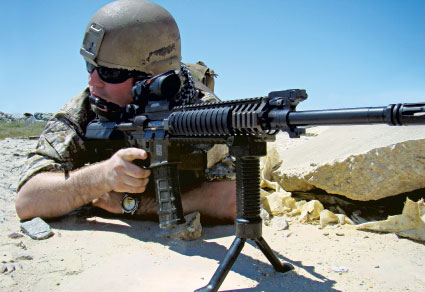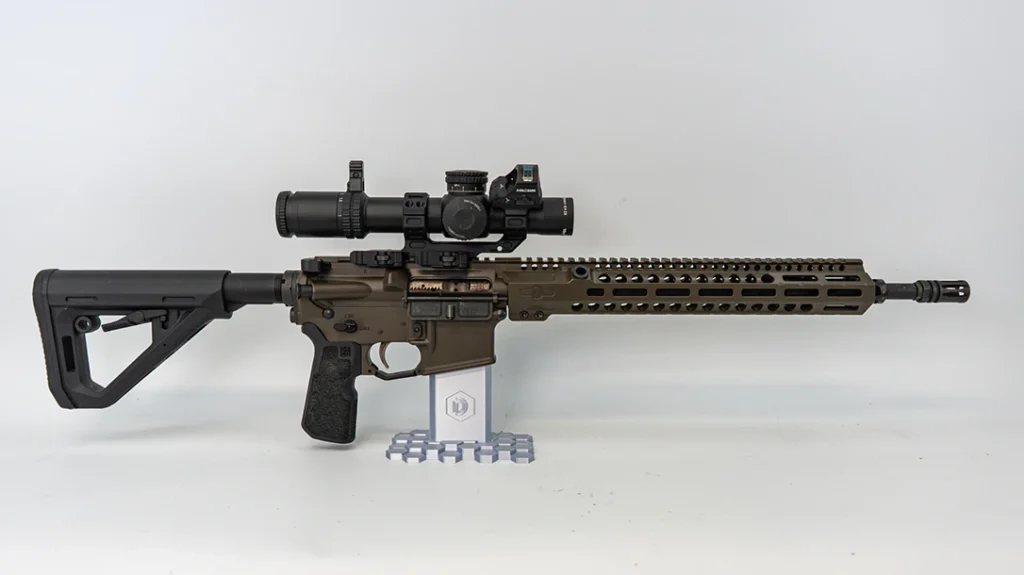The key to the Marine Corps’ success and its most basic element is the Marine rifleman. A tough, tenacious warrior that the German soldiers of World War II found to be so ferocious that they gave him the nickname “Teufel-hunden” or Devil Dog. The Marine rifleman is an extremely effective and efficient killing machine on the battlefield.
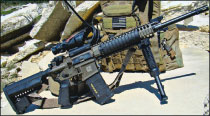 One of the tools that make Marines so effective is the weapons with which they’re armed. The standard fire team is made of four Marines armed with three M4 or M16 rifles (the fire team leader carries an M203 40mm grenade launcher) and an M249 SAW (squad automatic weapon). This configuration of men and weapons has served the Marine Corps well for nearly 20 years, but in recent years, and especially with the greatly increased operational tempo, the time has come for an update. The biggest impetus for this evolution has been the change from Cold War-style massed infantry tactics, where a heavy base of fire from a SAW would allow the fire team to operate and maneuver in the open environments of Eastern Europe, to a more fluid CQB (close quarters battle) unit in urban Iraq.
One of the tools that make Marines so effective is the weapons with which they’re armed. The standard fire team is made of four Marines armed with three M4 or M16 rifles (the fire team leader carries an M203 40mm grenade launcher) and an M249 SAW (squad automatic weapon). This configuration of men and weapons has served the Marine Corps well for nearly 20 years, but in recent years, and especially with the greatly increased operational tempo, the time has come for an update. The biggest impetus for this evolution has been the change from Cold War-style massed infantry tactics, where a heavy base of fire from a SAW would allow the fire team to operate and maneuver in the open environments of Eastern Europe, to a more fluid CQB (close quarters battle) unit in urban Iraq.
Another consideration is the current fighting environment. When the M249 is in condition 1 (bolt charged to the rear, locked, and ready to fire), the chamber and feed area is open to sand, dirt, and debris. A further detriment to the combat longevity of the SAW gunner is the weapon’s profile. The fact that it is easily recognizable as a belt-fed, light machinegun makes the SAW gunner a high-priority target for enemy snipers hoping to eliminate the fire team’s most casualty-producing weapon. With a large carrier for the cartridge belt hanging beneath the weapon and a bipod off the gas block, it is markedly different from what the other fire team members are carrying.
Advertisement — Continue Reading Below
Another consideration for reconfiguring the fire team is that, with its open-bolt and belt-fed operation, the SAW has a reduced probability of first-round ignition over something like a closed-bolt, magazine-fed M16. With a round chambered and locked in an M16, the trigger mechanism simply has to release the hammer and strike the primer causing the chambered round to fire. This gives better than 99 percent first round ignition probability, a must-have when patrolling or clearing a building. With a belt-fed machine gun the cartridge must be stripped from the metal link, fed into the chamber, and the bolt locked into the barrel extension. This presents a higher potential for a first-round malfunction, meaning that in house-to-house fighting, the SAW gunner can never be the first man through a door.
U.S.M.C. Solicitation
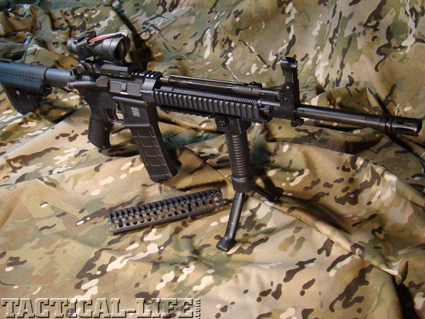
Those who have not recognized the potential of a magazine fed, light automatic rifle are still fighting the last war and not looking to the great majority of operations undertaken today. The LWRC (Land Warfare Resource Corporation) IAR (Infantry Automatic Rifle) was born of a solicitation by the U.S. Marines to address these developing issues. The Marines have a set of criteria they want in the next automatic infantry rifle. The basic concept is to keep the weapon as simple as possible while having a lightweight, magazine-fed rifle capable of continuous, accurate fire. The weapon should fire from standard M16/M4 magazines and be provided with an optional 60- to 100-round magazines for use in the sustained fire role.
To the casual observer, LWRC’s IAR looks very conventional. Many of the parts in service to maintain the M16/M4 are cross compatible with the IAR. The armorer’s tools and troop training remain relevant. Soldiers and Marines really do like the M4. It is probably the most ergonomic of modern assault rifles, highly modular, lightweight, and simple to use. There are several generations of Marines that are familiar with its controls, balance and handling. Marines develop what is termed “muscle memory” throughout firearms training, making the weapon’s operation a seemingly unconscious affair.
A heavier barrel profile was used to help deal with the increased demands of a light machine gun role. Radial fins similar to those found on the Thomson submachine gun were included in the barrel profile to lighten the barrel and allow greater surface area for convection air-cooling of the barrel. While longitudinal flutes may reduce weight and help stiffen a barrel, they do little to increase the surface area that aids in the dispersion of heat. The radial fins of the LWRC IAR increase the surface area of the barrel by 15 percent.
Advertisement — Continue Reading Below
The rifling chosen is polygonal. Polygonal rifling forms the bullet to the lands and grooves instead of cutting into the bullet jacket. It improves barrel life, reduces friction, and creates a better gas seal behind the bullet, thus increasing velocity and stability. Cold hammer-forged barrels of 4150 steel are used for extreme durability and the chamber profile is optimized for reliability.
For these reasons, LWRC has taken the USMC solicitation, integrated it into an M4-style platform, added a dual-fire mode, and the reliability of their gas piston operating system. They have envisioned a solution that can be integrated with the least amount of burden to the government and its warriors.
Check out this article about the M19191A6 Light Machine Gun: The Stop-Gap Defender of Freedom
Advertisement — Continue Reading Below
Dual Fire Modes
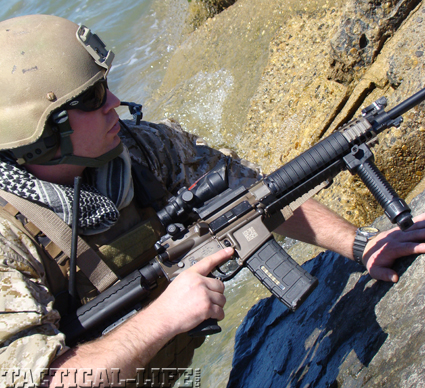
What truly sets the LWRC IAR apart from the rest of the pack is that it has two modes of fire. As a semi-automatic, it functions as a typical closed bolt rifle. If you toggle the selector from “semi” to “open bolt automatic,” the rifle’s bolt remains closed for the first shot, increasing ignition probability to 99.7 percent, allowing the infantry automatic rifleman to take point on patrol, initiate an ambush, or be the first through any door. After that first shot, the weapon reverts to an open bolt, allowing light-automatic fire support. When you release the trigger between strings of fire, the bolt remains to the rear, allowing convection air cooling of the barrel and chamber area. When you pull the trigger again, the bolt closes and fires continuously until the trigger is again released, with all the advantages of an open-bolt machine gun. To go back to closed bolt, semi-automatic fire, the operator switches the rifle’s selector back to semi. The bolt closes and chambers a round, but does not fire. When you pull the trigger, you get single shots with each pull. This offers all of the advantages of both types of systems with the disadvantages of neither.
Development of the dual-fire mode module came about as they envisioned a multi-role weapon, which is exactly what the Marines are asking for. They want a weapon that is light and handy enough that the automatic rifleman can use it for the everyday duties in the squad including patrol, counter sniping, and house clearing and others. The weight and overall dimensions must be in line with usual mission requirements. This also means that the operator must be able to take accurate, deliberate shots in semi-automatic mode, yet be capable of delivering fire support or suppression at sustained rates when required.
Made To Order
The LWRC IAR is rounded out with a quad rail fore-end that has a removable “return-to-zero” top rail that allows access to the piston operating components. The multi-position collapsible stock is manufactured by VLTOR and is the only sliding stock tested that survived every fall of the USMC drop-test protocols: 12 drops from every angle at a height of 1.7 meters. The rifle comes standard with an integrated folding sight in the gas block and a removable folding sight mounted at the rear of the receiver. The LWRC IAR is truly an evolutionary step forward in battlefield weapons in that they have combined the best features of an assault rifle with those of a light machine gun, with none of the drawbacks.
THE NEW IAR: Testfire & Evaluation
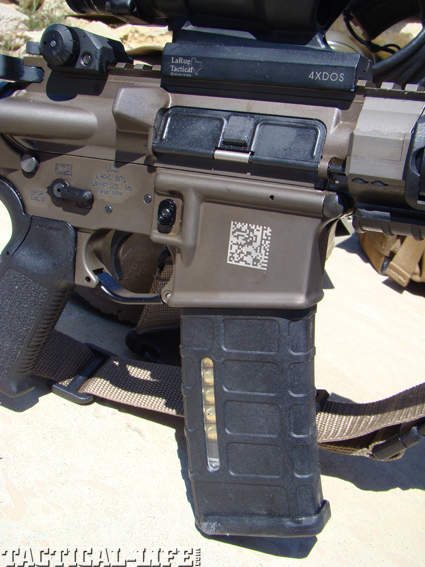
The right hand side of the magazine well features a UID (mil-standard 130M) marking required for all DOD-approved weapons. The aluminum parts are anodized in the SOCOM approved Flat Dark Earth finish.
Advertisement — Continue Reading Below
I shot the LWRC IAR at a recent carbine class. All of the operating controls are in the same locations and it is fully compatible with any piece of equipment that works on the existing issue M16/M4. When I settled down behind the trigger I was immediately impressed with the accuracy of the system. Making hits at 150 meters on a 6-inch by 6-inch steel plate with the EOTech optic was no challenge. I then rotated the selector to OBA (open bolt automatic) and fired off a few bursts.
There were two things that were immediately noticeable as great improvements over the M249 SAW. One was that it was perfectly controllable and didn’t try to climb off target. Because of the greatly reduced mass of the operating components, the weapon does not buck and gyrate in your hands as it is firing. The second thing I found to be unique was that the beaten zone was very small and tightly centered around the target. This has become a very important consideration due to the restrictive ROE (rules of engagement) that our troops operate under.
The automatic weapon suppressive-fire role has changed from that of large cone of fire/beaten zone against massed advancing troops to that of surgical suppressive fire on a window or door—the LWRC IAR reflects that. Collateral damage is reduced and “hearts and minds” are won. Nearly 1,500 rounds fired in a two-hour period, mostly on OBA. A fairly small sample size to be sure, but there were no reported stoppages and the weapon was not cleaned or lubricated in any way.
Advertisement — Continue Reading Below
